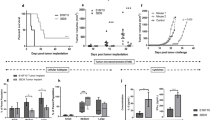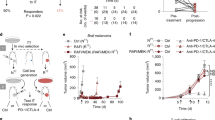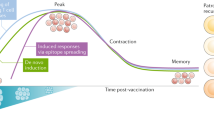Abstract
Malignant melanoma is one of the deadliest forms of skin cancer and its incidence is expected to rise over the next two decades. At present, there are no effective therapies for advanced melanoma. We have previously shown that administration of whole recombinant yeast expressing human MART-1 (hMART-IT) induces protective antimelanoma immunity in a B16F10 transplantable mouse model. In this study, we examine the effectiveness of the hMART-IT vaccine in a congenic strain of genetically engineered mouse model of melanoma, which recapitulates both the underlying genetics and the proper tumor microenvironment of naturally occurring melanoma. Subcutaneous administration of hMART-IT induced cytotoxicity against melanoma cells and antigen-specific production of Th1-specific cytokines by splenocytes. Weekly administration of hMART-IT significantly delayed the development of melanoma and prolonged the survival of mice compared with controls. Although histological analysis demonstrated diffuse infiltration of CD4+ T cells and CD8+ T cells, no reduction of regulatory T cells was observed, suggesting that hMART-IT cannot prevent immunotolerance in the tumor microenvironment. This study provides a proof of concept that genetically engineered mouse models lend valuable insights into immunotherapeutics being tested in the preclinical setting.
This is a preview of subscription content, access via your institution
Access options
Subscribe to this journal
Receive 12 print issues and online access
$259.00 per year
only $21.58 per issue
Buy this article
- Purchase on Springer Link
- Instant access to full article PDF
Prices may be subject to local taxes which are calculated during checkout






Similar content being viewed by others
References
Garbe C, Leiter U . Melanoma epidemiology and trends. Clin Dermatol 2009; 27: 3–9.
Sala E, Mologni L, Truffa S, Gaetano C, Bollag GE, Gambacorti-Passerini C . BRAF silencing by short hairpin RNA or chemical blockade by PLX4032 leads to different responses in melanoma and thyroid carcinoma cells. Mol Cancer Res 2008; 6: 751–759.
Hersh EM, O’Day SJ, Ribas A, Samlowski WE, Gordon MS, Shechter DE et al. A phase 2 clinical trial of nab-paclitaxel in previously treated and chemotherapy-naive patients with metastatic melanoma. Cancer 2010; 116: 155–163.
Hodi FS, O’Day SJ, McDermott DF, Weber RW, Sosman JA, Haanen JB et al. Improved survival with ipilimumab in patients with metastatic melanoma. N Engl J Med 2010; 363: 711–723.
Riemann H, Takao J, Shellman YG, Hines WA, Edwards III CK, Franzusoff A et al. Generation of a prophylactic melanoma vaccine using whole recombinant yeast expressing MART-1. Exp Dermatol 2007; 16: 814–822.
Ostrand-Rosenberg S . Animal models of tumor immunity, immunotherapy and cancer vaccines. Curr Opin Immunol 2004; 16: 143–150.
Singh M, Johnson L . Using genetically engineered mouse models of cancer to aid drug development: an industry perspective. Clin Cancer Res 2006; 12: 5312–5328.
Lollini PL, Cavallo F, Nanni P, Forni G . Vaccines for tumour prevention. Nat Rev Cancer 2006; 6: 204–216.
Miller AJ, Mihm Jr MC . Melanoma. N Engl J Med 2006; 355: 51–65.
Gray-Schopfer V, Wellbrock C, Marais R . Melanoma biology and new targeted therapy. Nature 2007; 445: 851–857.
Hussussian CJ, Struewing JP, Goldstein AM, Higgins PA, Ally DS, Sheahan MD et al. Germline p16 mutations in familial melanoma. Nat Genet 1994; 8: 15–21.
Bloethner S, Chen B, Hemminki K, Muller-Berghaus J, Ugurel S, Schadendorf D et al. Effect of common B-RAF and N-RAS mutations on global gene expression in melanoma cell lines. Carcinogenesis 2005; 26: 1224–1232.
Powell MB, Hyman P, Bell OD, Balmain A, Brown K, Alberts D et al. Hyperpigmentation and melanocytic hyperplasia in transgenic mice expressing the human T24 Ha-ras gene regulated by a mouse tyrosinase promoter. Mol Carcinog 1995; 12: 82–90.
Ackermann J, Frutschi M, Kaloulis K, McKee T, Trumpp A, Beermann F . Metastasizing melanoma formation caused by expression of activated N-RasQ61K on an INK4a-deficient background. Cancer Res 2005; 65: 4005–4011.
Chin L, Pomerantz J, Polsky D, Jacobson M, Cohen C, Cordon-Cardo C et al. Cooperative effects of INK4a and ras in melanoma susceptibility in vivo. Genes Dev 1997; 11: 2822–2834.
Lazarov M, Kubo Y, Cai T, Dajee M, Tarutani M, Lin Q et al. CDK4 coexpression with Ras generates malignant human epidermal tumorigenesis. Nat Med 2002; 8: 1105–1114.
Dankort D, Curley DP, Cartlidge RA, Nelson B, Karnezis AN, Damsky Jr WE et al. Braf(V600E) cooperates with Pten loss to induce metastatic melanoma. Nat Genet 2009; 41: 544–552.
Milagre C, Dhomen N, Geyer FC, Hayward R, Lambros M, Reis-Filho JS et al. A mouse model of melanoma driven by oncogenic KRAS. Cancer Res 2010; 70: 5549–5557.
Nobori T, Miura K, Wu DJ, Lois A, Takabayashi K, Carson DA . Deletions of the cyclin-dependent kinase-4 inhibitor gene in multiple human cancers. Nature 1994; 368: 753–756.
Chin L, Pomerantz J, DePinho RA . The INK4a/ARF tumor suppressor: one gene--two products--two pathways. Trends Biochem Sci 1998; 23: 291–296.
Lubomierski N, Kersting M, Bert T, Muench K, Wulbrand U, Schuermann M et al. Tumor suppressor genes in the 9p21 gene cluster are selective targets of inactivation in neuroendocrine gastroenteropancreatic tumors. Cancer Res 2001; 61: 5905–5910.
Oble DA, Loewe R, Yu P, Mihm Jr MC . Focus on TILs: prognostic significance of tumor infiltrating lymphocytes in human melanoma. Cancer Immun 2009; 9: 3.
Gimotty PA, Guerry D, Ming ME, Elenitsas R, Xu X, Czerniecki B et al. Thin primary cutaneous malignant melanoma: a prognostic tree for 10-year metastasis is more accurate than American Joint Committee on Cancer staging. J Clin Oncol 2004; 22: 3668–3676.
Schmid FA, Elmer I, Tarnowski GS . Genetic determination of differential inflammatory reactivity and subcutaneous tumor susceptibility of AKR-J and C57BL-6J mice to 7,12-dimethylbenz-[a]anthracene. Cancer Res 1969; 29: 1585–1589.
Hennings H, Glick AB, Lowry DT, Krsmanovic LS, Sly LM, Yuspa SH . FVB/N mice: an inbred strain sensitive to the chemical induction of squamous cell carcinomas in the skin. Carcinogenesis 1993; 14: 2353–2358.
Newman SL, Holly A . Candida albicans is phagocytosed, killed, and processed for antigen presentation by human dendritic cells. Infect Immun 2001; 69: 6813–6822.
Engering AJ, Cella M, Fluitsma D, Brockhaus M, Hoefsmit EC, Lanzavecchia A et al. The mannose receptor functions as a high capacity and broad specificity antigen receptor in human dendritic cells. Eur J Immunol 1997; 27: 2417–2425.
Hattori Y, Kawakami S, Suzuki S, Yamashita F, Hashida M . Enhancement of immune responses by DNA vaccination through targeted gene delivery using mannosylated cationic liposome formulations following intravenous administration in mice. Biochem Biophys Res Commun 2004; 317: 992–999.
Lam JS, Mansour MK, Specht CA, Levitz SM . A model vaccine exploiting fungal mannosylation to increase antigen immunogenicity. J Immunol 2005; 175: 7496–7503.
Tan MC, Mommaas AM, Drijfhout JW, Jordens R, Onderwater JJ, Verwoerd D et al. Mannose receptor-mediated uptake of antigens strongly enhances HLA class II-restricted antigen presentation by cultured dendritic cells. Eur J Immunol 1997; 27: 2426–2435.
Kaisho T, Akira S . Dendritic-cell function in Toll-like receptor- and MyD88-knockout mice. Trends Immunol 2001; 22: 78–83.
Underhill DM, Ozinsky A . Phagocytosis of microbes: complexity in action. Annu Rev Immunol 2002; 20: 825–852.
Atkins MB, Lotze MT, Dutcher JP, Fisher RI, Weiss G, Margolin K et al. High-dose recombinant interleukin 2 therapy for patients with metastatic melanoma: analysis of 270 patients treated between 1985 and 1993. J Clin Oncol 1999; 17: 2105–2116.
Gollob JA, Mier JW, Veenstra K, McDermott DF, Clancy D, Clancy M et al. Phase I trial of twice-weekly intravenous interleukin 12 in patients with metastatic renal cell cancer or malignant melanoma: ability to maintain IFN-gamma induction is associated with clinical response. Clin Cancer Res 2000; 6: 1678–1692.
Gollob JA, Veenstra KG, Parker RA, Mier JW, McDermott DF, Clancy D et al. Phase I trial of concurrent twice-weekly recombinant human interleukin-12 plus low-dose IL-2 in patients with melanoma or renal cell carcinoma. J Clin Oncol 2003; 21: 2564–2573.
Javia LR, Rosenberg SA . CD4+CD25+ suppressor lymphocytes in the circulation of patients immunized against melanoma antigens. J Immunother 2003; 26: 85–93.
Viguier M, Lemaitre F, Verola O, Cho MS, Gorochov G, Dubertret L et al. Foxp3 expressing CD4+CD25(high) regulatory T cells are overrepresented in human metastatic melanoma lymph nodes and inhibit the function of infiltrating T cells. J Immunol 2004; 173: 1444–1453.
Sutmuller RP, van Duivenvoorde LM, van Elsas A, Schumacher TN, Wildenberg ME, Allison JP et al. Synergism of cytotoxic T lymphocyte-associated antigen 4 blockade and depletion of CD25(+) regulatory T cells in antitumor therapy reveals alternative pathways for suppression of autoreactive cytotoxic T lymphocyte responses. J Exp Med 2001; 194: 823–832.
Tormo D, Ferrer A, Bosch P, Gaffal E, Basner-Tschakarjan E, Wenzel J et al. Therapeutic efficacy of antigen-specific vaccination and toll-like receptor stimulation against established transplanted and autochthonous melanoma in mice. Cancer Res 2006; 66: 5427–5435.
Kohlmeyer J, Cron M, Landsberg J, Bald T, Renn M, Mikus S et al. Complete regression of advanced primary and metastatic mouse melanomas following combination chemoimmunotherapy. Cancer Res 2009; 69: 6265–6274.
Dudley ME, Wunderlich JR, Robbins PF, Yang JC, Hwu P, Schwartzentruber DJ et al. Cancer regression and autoimmunity in patients after clonal repopulation with antitumor lymphocytes. Science 2002; 298: 850–854.
Lutsiak ME, Semnani RT, De Pascalis R, Kashmiri SV, Schlom J, Sabzevari H . Inhibition of CD4(+)25+ T regulatory cell function implicated in enhanced immune response by low-dose cyclophosphamide. Blood 2005; 105: 2862–2868.
Radojcic V, Bezak KB, Skarica M, Pletneva MA, Yoshimura K, Schulick RD et al. Cyclophosphamide resets dendritic cell homeostasis and enhances antitumor immunity through effects that extend beyond regulatory T cell elimination. Cancer Immunol Immunother 2010; 59: 137–148.
Nakahara T, Uchi H, Lesokhin AM, Avogadri F, Rizzuto GA, Hirschhorn-Cymerman D et al. Cyclophosphamide enhances immunity by modulating the balance of dendritic cell subsets in lymphoid organs. Blood 2010; 115: 4384–4392.
Waterhouse P, Penninger JM, Timms E, Wakeham A, Shahinian A, Lee KP et al. Lymphoproliferative disorders with early lethality in mice deficient in Ctla-4. Science 1995; 270: 985–988.
Wing K, Onishi Y, Prieto-Martin P, Yamaguchi T, Miyara M, Fehervari Z et al. CTLA-4 control over Foxp3+ regulatory T cell function. Science 2008; 322: 271–275.
Stubbs AC, Martin KS, Coeshott C, Skaates SV, Kuritzkes DR, Bellgrau D et al. Whole recombinant yeast vaccine activates dendritic cells and elicits protective cell-mediated immunity. Nat Med 2001; 7: 625–629.
Bohm W, Thoma S, Leithauser F, Moller P, Schirmbeck R, Reimann J . T cell-mediated, IFN-gamma-facilitated rejection of murine B16 melanomas. J Immunol 1998; 161: 897–908.
Acknowledgements
This work was supported by grants to MF from the Melanoma Research Foundation and Dermatology Foundation. We thank Kayo Okamura and Dr Joe Takeo (UCD, Department of Dermatology) for their technical support. We thank Drs Donald Bellgrau, Richard Duke (UCD, Department of Immunology and Medical Oncology) and Alex Franzusoff (GlobeImmune Inc., Aurora, CO, USA) for their intellectual support. UCD flow core (Alistaire S Acosta and Karen Helm, supported by NIH grant P30 CA046934) helped with flow cytometry and cytokine analyses.
Author information
Authors and Affiliations
Corresponding author
Ethics declarations
Competing interests
The authors declare no conflict of interest.
Rights and permissions
About this article
Cite this article
Tanaka, A., Jensen, J., Prado, R. et al. Whole recombinant yeast vaccine induces antitumor immunity and improves survival in a genetically engineered mouse model of melanoma. Gene Ther 18, 827–834 (2011). https://doi.org/10.1038/gt.2011.28
Received:
Revised:
Accepted:
Published:
Issue Date:
DOI: https://doi.org/10.1038/gt.2011.28



